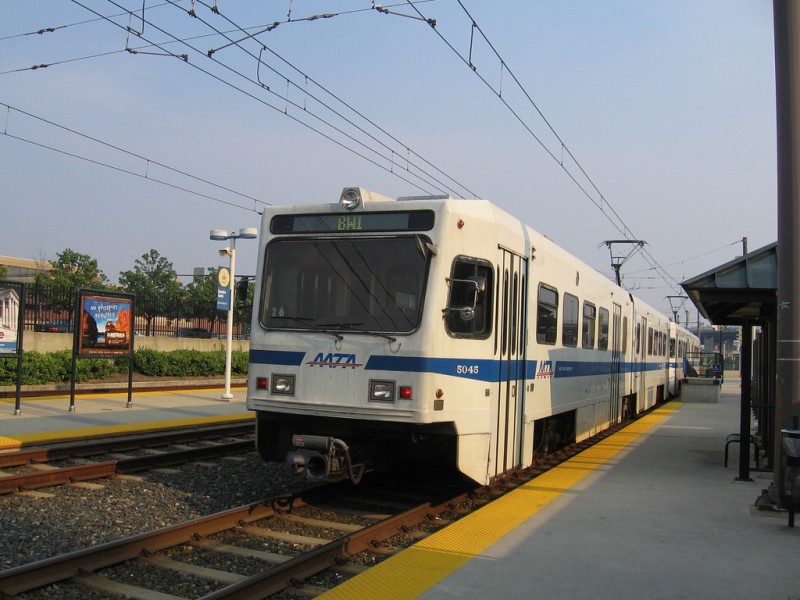How Maryland handcuffs its transit system, and how that could change

Image by Elliot Margolies licensed under Creative Commons.
In Maryland, the state’s mass transit system — most of it based in the Baltimore metro area — has to pay for at least 35% of its operating budget through rider fares. The law makes transit service less frequent and more expensive. There’s a bill in the Maryland state legislature that would change this.
That requirement is Maryland’s farebox recovery mandate, which affects only Maryland Transit Administration (MTA) products, like MTA local (aka Baltimore’s bus service) and commuter buses (which primarily serve the District), the three MARC commuter lines, and Baltimore’s Light Rail and Metro subway lines. Proposed legislation in Maryland’s state legislature this year could finally repeal this law.
As GGWash contributor Matt Johnson has explained, “A ‘farebox recovery’ rate is the amount of operating expenses that fares cover. For example, if a system costs $1 million to operate every year and takes in $500,000 dollars in fares, it would have a farebox recovery of 50%. A profitable system would have a number above 100%.”
Current state law mandates a 35% farebox recovery rate for the MTA. Since 2009, when the Maryland General Assembly set this number, MTA has recovered around 28%. (Comparison with other systems requires going to the National Transit Database, which uses a different method for calculating farebox recovery. In the NTD, MTA is at 20% and WMATA is at 44%)
There are no US public transportation systems that recover 100% of operating costs through farebox revenues. Those that cover more than 35% tend to be ones that provide the most frequent service throughout the week. Rail service generally covers a higher percentage of its expenses than bus service. With a system that serves a high proportion of riders (64%) with bus versus rail service, MTA has a lower farebox recovery ratio that systems than provide more service via rail.
Baltimore's light rail system is one of the many transit services that MTA provides, and that are negatively affected by Maryland's farebox recovery law. Image by Austin Cross licensed under Creative Commons.
The farebox recovery mandate hurts Maryland transit users, especially those who need transit most
Farebox recovery laws are exceedingly rare in the United States, and Maryland is one of the few states that legally require a transit provider to cover a certain percentage of operating costs from fares.
The result of complying with this mandate is that MTA regularly has no choice but to refrain from investing in services and maintenance even if those things would grow ridership and revenues over time. In public meetings, MTA officials often cite the farebox recovery mandate as a limiting factor when responding to requests to provide service to growing employment sites or other destinations, like a new Amazon warehouse distribution facility in Baltimore.
This lack of investment is particularly troubling in the Baltimore region, where some 30 percent of residents do not own an automobile for personal transportation and face very long commute times while using MTA products.
In the 2015 installment of its annual report to the General Assembly about the farebox recovery ratio, MTA wrote that revenues are a function of ridership and that “research has established that ridership increases are driven first by service availability and quality, and secondly by economic factors such as the relative cost of transit compared to other modes of travel.”
The mandate came up in January during a public meeting about a recent decision affecting access to after school programs for Baltimore City Public Schools (BCPS) students. For seven years, BCPS provided students a pass that allowed unlimited rides on MTA products between the hours of 5:30 am and 8 pm. When MTA changed the cutoff for using the pass to 6 pm, MTA’s Sean Adgerson, Deputy Chief Operating Officer, told parents and advocates the farebox recovery mandate was a primary reason for the change.
A bill before the Maryland state legislature could make the farebox recovery mandate go away
Baltimore-area legislators have been working to remove the farebox recovery mandate for the last two legislative sessions. This year, Maryland House of Delegates Bill 271 has passed out of two committees and received a favorable vote from the full House. Its Senate counterpart, Senate Bill 484, passed out of the Senate Budget & Taxation committee and awaits a full Senate vote. If the bill gets Governor Larry Hogan’s signature, the MTA could finally begin a process of planning and innovation not tied to an arbitrary farebox recovery rate.
The legislation is receiving broad support among central Maryland transit advocates, business leaders and riders. They have already come together to form a coalition that is supporting this legislation as the first in what is hopefully a long line of actions to improve Maryland’s transit systems.
The Get Maryland Moving coalition formed in fall 2016 to give individuals and organizations that think better public transportation is important a way to come together and push for improvements. The group chose repealing the farebox recovery mandate as its first campaign.
“A critical first step is to ensure that the citizens of Maryland have access to employment centers through a safe, reliable and efficient transportation system,” says Reverend Glenn Smith, the coalition’s co-chair.
